Learn how to make lard. A smooth, creamy, and neutral fat perfect for baking, grilling, frying, and more. This versatile fat is solid at room temperature and liquid when warm. Plus, it is shelf stable.
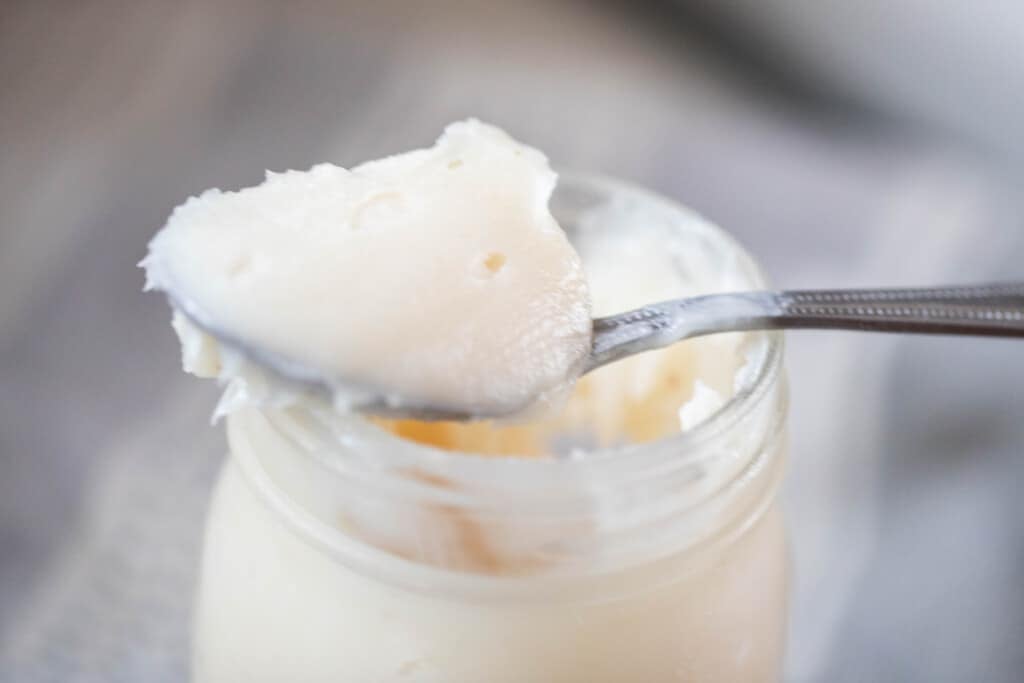
I’m currently in the process of using up all the meat in my freezer and had a big ol’ package of pork fat from Fed From The Farm so I could render lard. Now you may have a negative connotation about lard. Put those aside because it can be a very healthy fat to cook with.
The thing is you need to buy healthy pigs that are pastured raised from a local farmer or a place like Fed From The Farm because the not-so-good for you things get concentrated in the fat.
When the pigs are pasture raised, eating acorns, tilling up the soil, soaking up the sunshine (increasing the amount of vitamin D in the fat and meat), the fat and meat are just so much healthier.
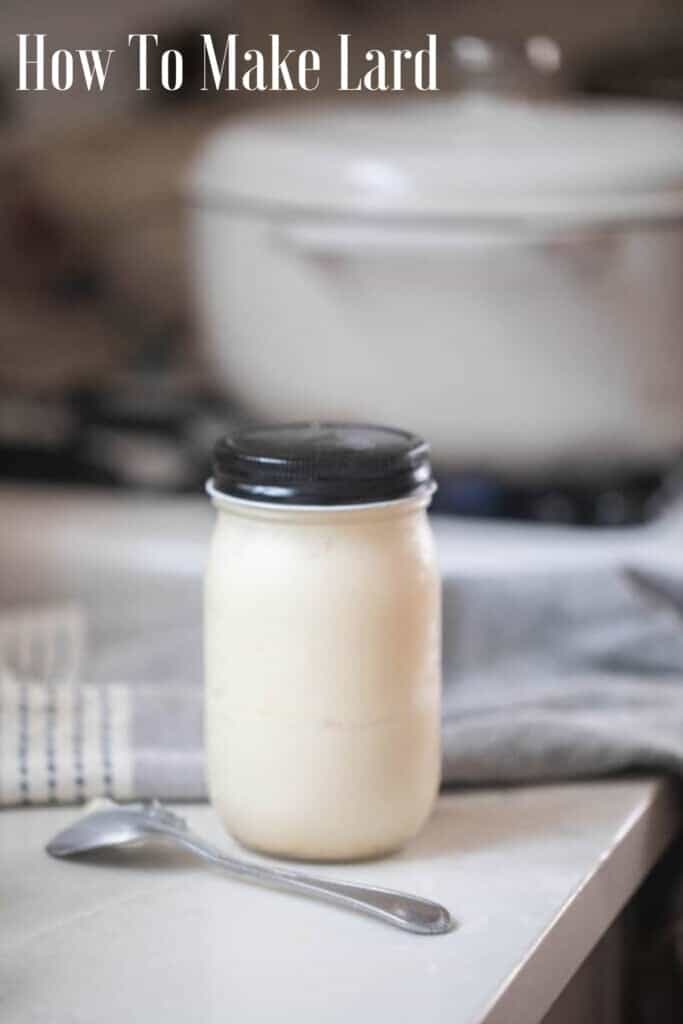
In more recent years, we have been tricked by modern marketing to believe this once traditional fat is unhealthy, while certain oils like canola oil, corn oil, and vegetable oil are better.
They simply are not. Animal fat (like butter, lard, and tallow) are healthy fats to cook and bake with.
It is good that you can use the fat in this way because when you buy a whole animal, you don’t want these things to go to waste.
A Traditional Fat
Traditional cultures use the entire animal (aka nose to tail), and many times this type of fat is just thrown away. So many times you can get it pretty cheap, because unless you are going to render lard it’s pretty much useless.
The rendering process is very simple. It just takes a little time and patience. What you are left with is this creamy mild rendered fat that is perfect for making flaky pie crust, tortillas, biscuits, and more.
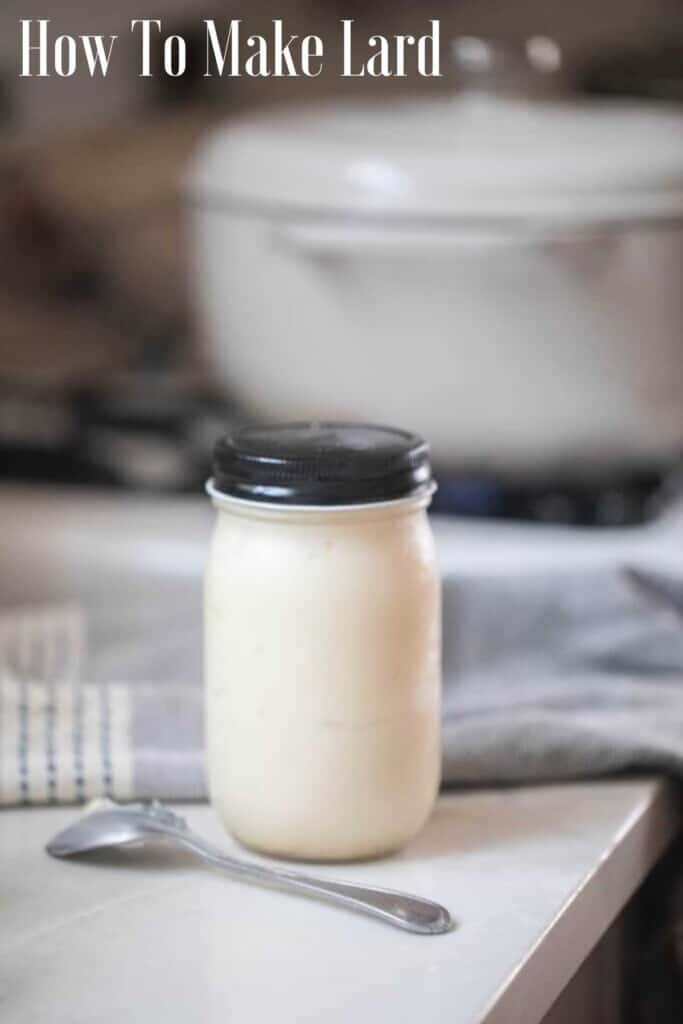
Benefits Of Lard
- The quality of the lard is important. Healthy pastured pigs produce the healthiest lard. Healthy lard has higher amounts of fat soluble vitamins like A, E, D, K.
- High melt point essential for pie crusts and biscuits where you have to cut in the fat.
- Healthy fat. Make sure to choose fat from a pastured raised pig to make this recipe. Avoid commercial pig fat because toxins concentrate in the fat and these animals are not fed healthy feed. Pastured lard is full of monounsaturated fats (although saturated fats aren’t bad either), b vitamins, and minerals.
- Many people say that lard has a high smoke point. Interestingly enough, the smoke point is around 374 degrees, lower than olive oil. Yet, many have great success using this fat for frying and other high heat techniques.
Types Of Pig Fat
There are three types of fat that is used for making good lard:
- Back fat – This comes from the back of the pig and is the most abundant on a typical pig.
- Pork belly – It contains much more meat (it is usually what bacon is made of) compared to other types of fat. Not the best for lard.
- Leaf fat – (This makes the coveted leaf lard) It is smooth, creamy, and neutral lard that has been rendered from the leaf-shaped fat surrounding the pig’s kidneys and loin.
Tips:
- This is best cooked low and slow for a few hours. If the stove is set to high heat, it may burn the raw fat.
- A great way to speed up the process is to put the fat through a meat grinder to get the pieces super small.
- When you are cooking down the fat, there will be some meat that will not render out. Don’t expect the pot to be completely melted.
- The slower the fat is cooked, the whiter and more neutral-smelling it will be. If it gets cooked on too high of heat it can burn and give the lard an off, smokey, or burnt flavor. Not very appealing.
- If you are able, use pastured raised over conventional grocery store fat.
- Cooking beef tallow is similar to making pork lard. Find how to render beef fat here.
- Another great option is to ask a local butcher if they have any pork fat.
- It is much easier to cut if the fat is frozen slightly.
This post contains affiliate links, which means I make a small commission at no extra cost to you. See my full disclosure here.
Tools you may need:
Knife
Cutting board
Large pot or dutch oven. If you only have a bit of fat to make into lard, you can even do this in a cast iron pan.
Slow cooker (If choosing the slow cooker option) or Instant Pot
FAQ
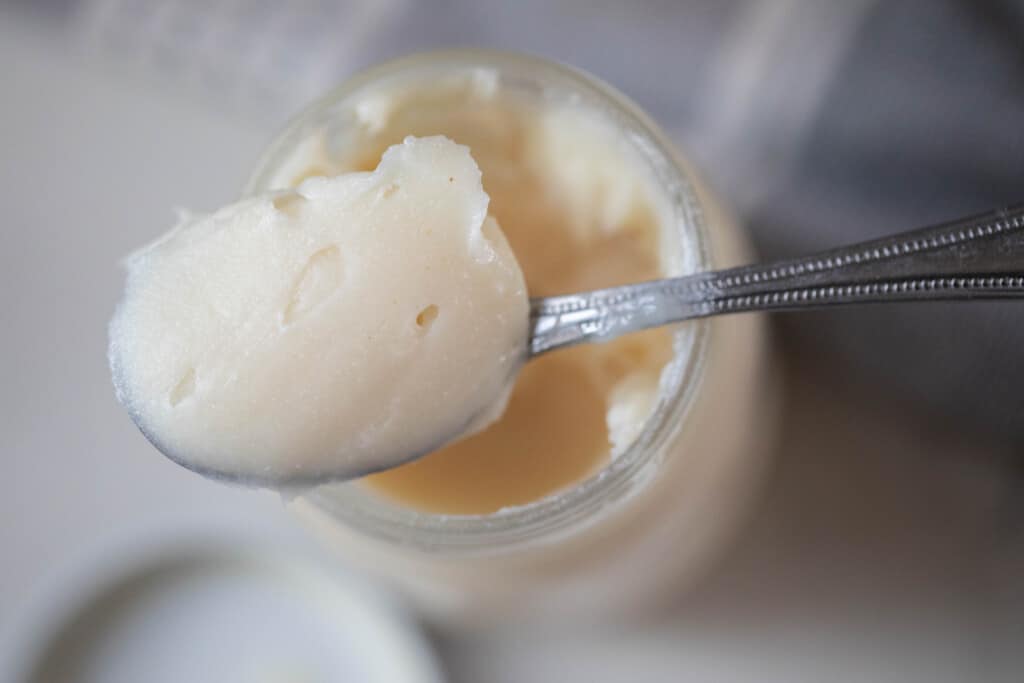
Is lard just bacon grease?
No. While technically it is bacon fat, it is cooked at a much higher temperature and contains a lot more flavor than white lard.
Can you make lard from any animal?
Technically, lard only comes from pig fat. Tallow is made from beef or lamb fat. Essentially they are very similar, just different napes.
How long does lard last?
In the refrigerator, lard will last up to a year, at room temperature the shelf life is 4-6 months.
Can you tell if lard goes bad?
Yes. It smells really bad. You will know if it has gone bad. I recommend keeping the lard in a cool place like the refrigerator, freezer, a cool basement, or root cellar.
If you find mold, it has also gone bad. The thing with mold is that pure fat shouldn’t harbor mold, so if this happens, there was water that was left in the lard, either by not cooking long enough, or not being strained.
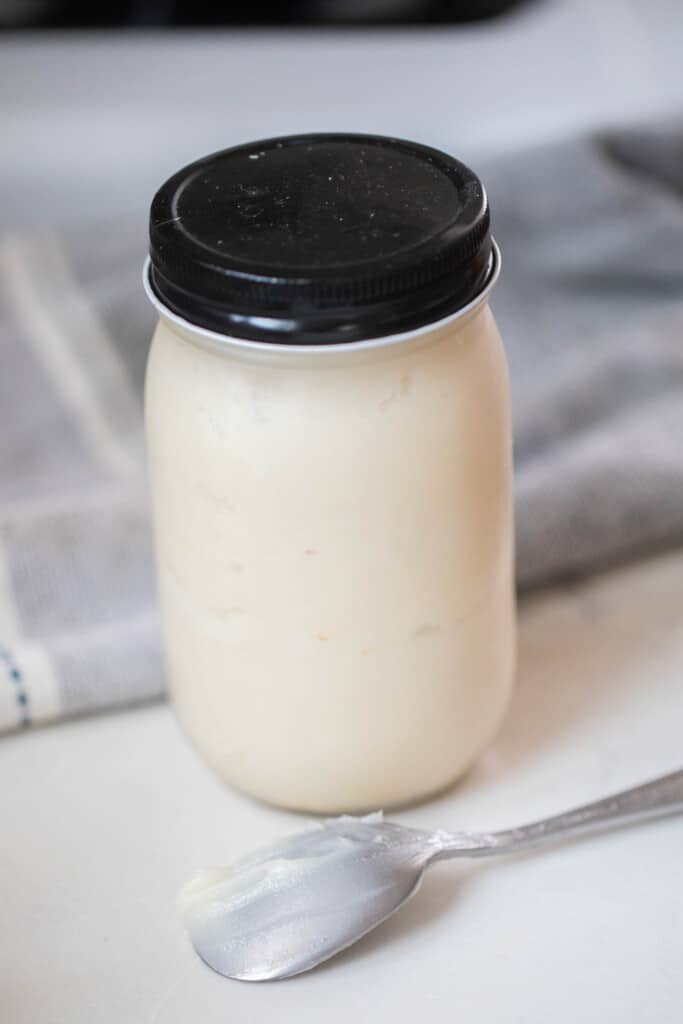
How To Make Lard On The Stove Top
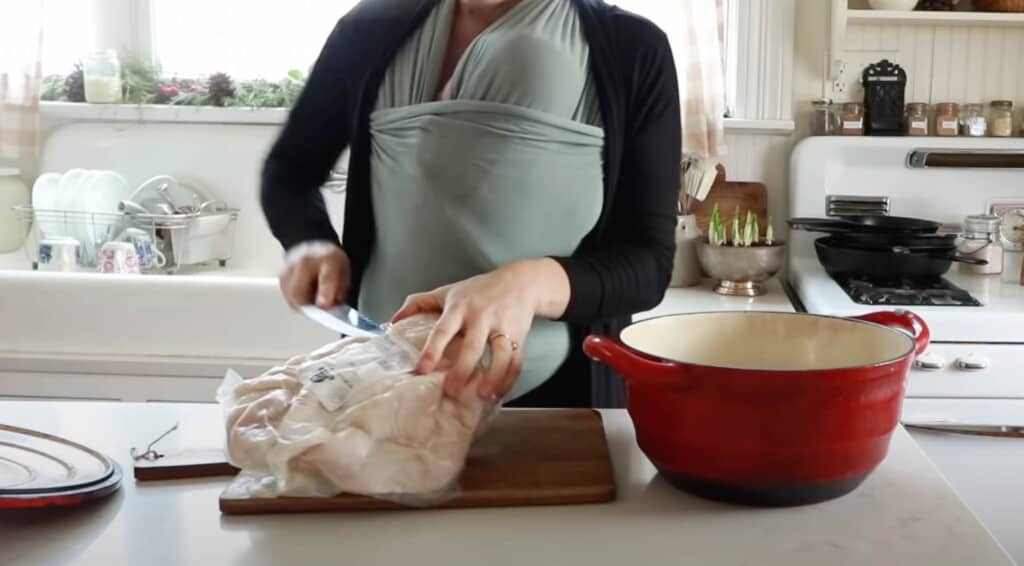
With a sharp knife, cut pork fat into small pieces, about 1-2 inch portions. To make it easier to cut, stick the fat in the freezer for about an hour before you are planning to make this recipe.
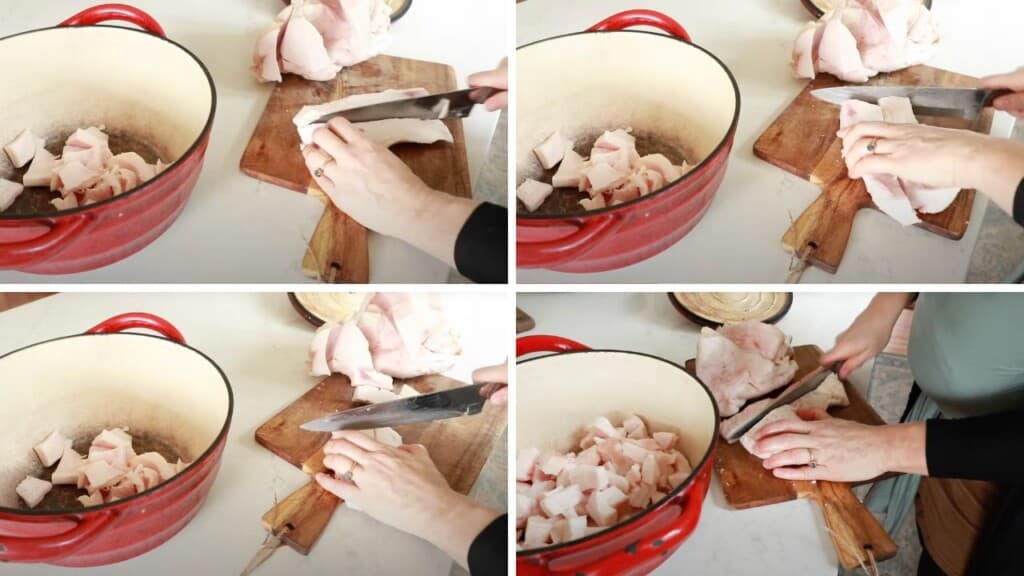
Place into a cast iron dutch oven or heavy pot and place over low heat with a lid for a few hours, about 1-3 hours. It can take a long time.
You don’t want to cook it really fast. Like when you cook bacon and it cooks at a high heat, you are technically rendering fat, but since you are cooking it at such a high heat it definitely has its own strong flavor. If you want a more mild flavor that you can use for say biscuits or homemade pie crusts, you want to cook it low and slow.
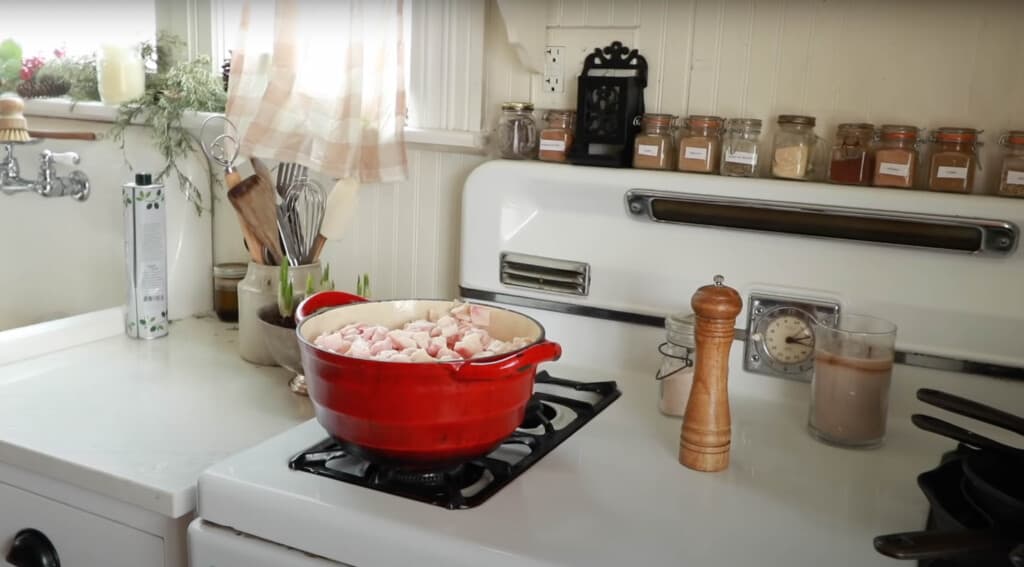
Occasionally stir the fat pieces so nothing is sticking to the bottom.
It will be done when all the fat has separated from the meat and the crackling will settle at the bottom.
Strain
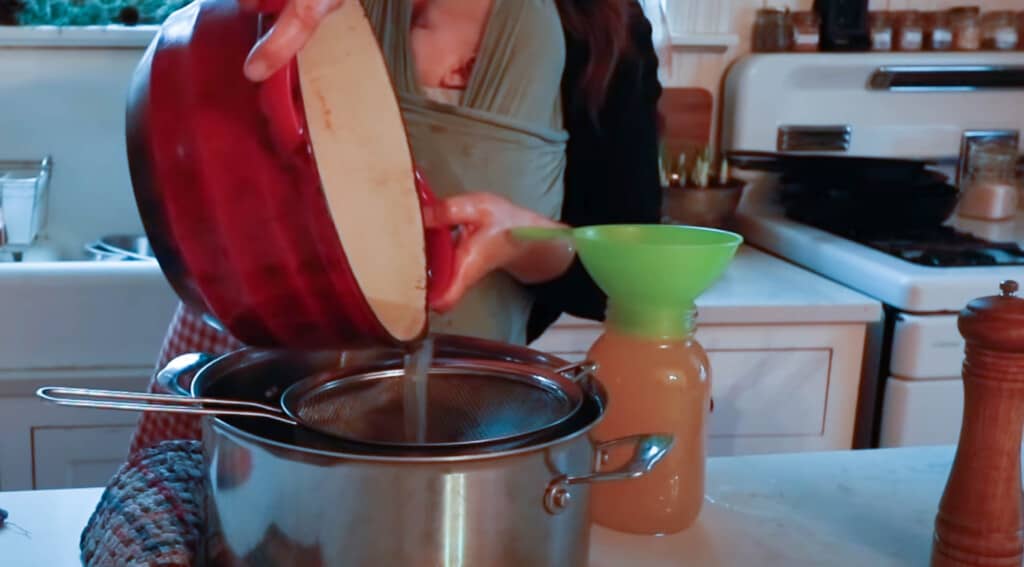
After the pig fat has rendered, while it is still hot, carefully pour the liquid fat through a fine mesh strainer (a coffee filter or paper towel also works) into a bowl or container. Not everything will completely melt. There will be bits of meat and other pieces that don’t render. Don’t toss them. Add a little salt to the crackling and enjoy.
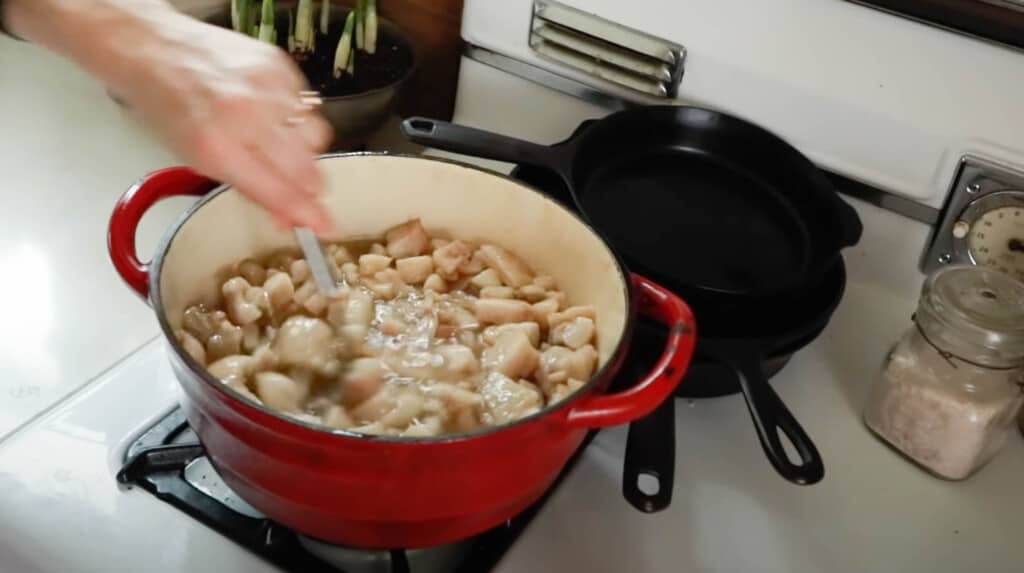
Pour into glass jars and allow to cool at room temperature or in the refrigerator. I prefer at room temperature because the steam being released while cooling in the fridge can get trapped on the lid and go back into the lard. This could contribute to mold growth.
Now it is ready to use. Keep it in the fridge or freezer for up to a year, or leave it at room temperature for 4-6 months.
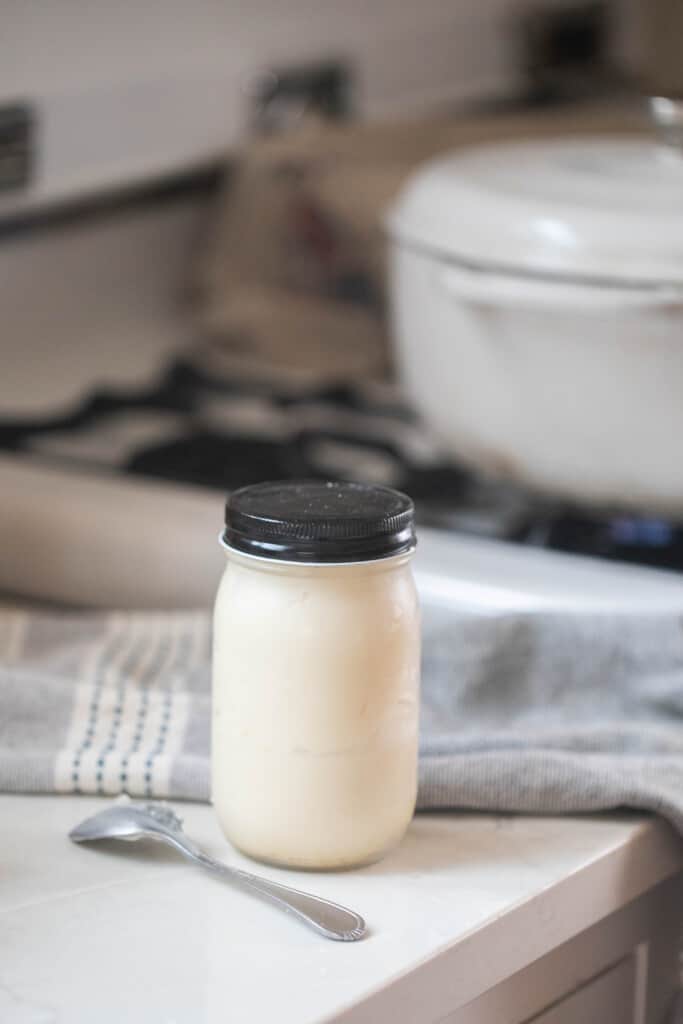
How To Make Lard In The Slow Cooker
With a sharp knife, cut pork fat into small cubes
Place into a slow cooker on low heat and cook for 8-10 hours.
Strain through a fine mesh strainer into a. bowl and transfer into mason jars.
How To Make Lard In The Instant Pot:
Place cubed fat into the Instant Pot and press the warm function.
Allow it to cook until completely melted. Stir occasionally.
This will take 1-3 hours depending on the amount of fat that was started with.
How To Use Lard:
It is a very versatile fat that can be used in a variety ways. Use your own lard in any recipe calling for vegetable shortening, butter, olive oil, or coconut oil substitute. It can be used for baking, sautéing, grilling, and even deep frying.
Find More Farm To Table Recipes:
- Chicken Feet Bone Broth
- Pork Steaks With Creamy Onion Gravy
- Sausage And Apple Stuffed Acorn Squash
- Maple Roasted Chicken With Sweet Potatoes And Apples
- The Best’s Shepherd’s Pie From Scratch
If you make this recipe and love it, I would love it if you gave it 5 stars! Tag me on Instagram @farmhouseonboone with your delicious creation.
Lard
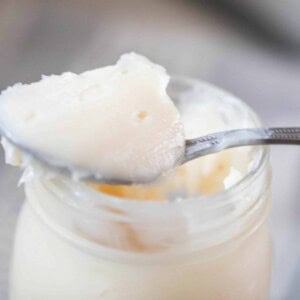
Ingredients
- Pork Fat
Instructions
- With a sharp knife, cut pork fat into small pieces, about 1-2 inch portions.
- Place into a cast iron dutch oven or heavy pot and place over low heat with a lid for a few hours, about 1-3 hours. It can take a long time.
- Occasionally stir the fat pieces so nothing is sticking to the bottom.
You will know when it is done when all the fat has separated from the meat and the crackling will settle at the bottom. - After all the fat has rendered, while it is still hot, carefully pour the liquid fat through a fine mesh strainer (a coffee filter or paper towel also works) into a bowl or container. This filters out any bits.
- Pour into glass jars and allow to cool at room temperature or in the refrigerator.
- Now it is ready to use. Keep it in the fridge or freezer for up to a year, or leave it at room temperature for 4-6 months.
Notes
- To make it easier to cut, stick the fat in the freezer for about an hour before you are planning to make this recipe.
- You don’t want to cook it really fast. Like when you cook bacon and it cooks at a high heat, you are technically rendering fat, but since you are cooking it at such a high heat it definitely has its own strong flavor. If you want a more mild flavor that you can use for say biscuits or homemade pie crusts, you want to cook it low and slow.
- I prefer to cool the lard at room temperature because the steam being released while cooling in the fridge can get trapped on the lid and go back into the lard. This could contribute to mold growth.
Nutrition information is automatically calculated, so should only be used as an approximation.
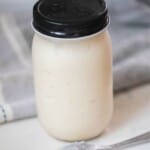
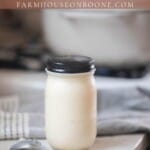
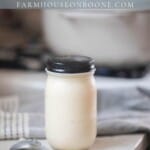
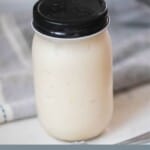
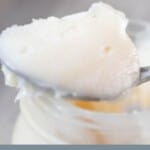
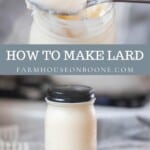
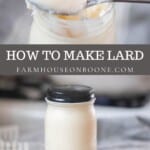
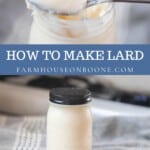



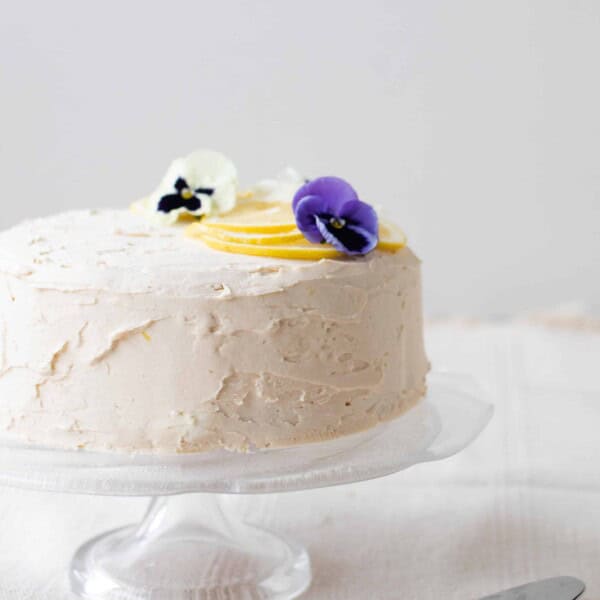






No where does it say how much fat to start with and about how much lard you should end up with. I did about 9 lbs last night and ended up with 2 3/4 quarts. Does this sound right? It was my first time making lard.
Yes, that sounds right! You can use however much fat you’d like, as I’m just sharing the process for rendering the lard.
My rendered lard is like liquid, not solid. What did I do wrong?
My grandmother always had a can on the stove for grease! She used it for frying everything. (The olden days!♥️). BTW, I can’t WAIT for your cookbook!! Everything I make is Farmhouse on Boone!
I’m excited for it, too! Can’t wait to share it with you!
Hi Lisa, where can I buy organic pasture raised pig fat lard. Any recommendations would be greatly appreciated. Love your show. Lots of helpful information. Lucy
Thank you so much Lucy. I get it either from my sisters farm or Fed From The Farm. Your best bet is to try to find a local farmer near your.
I have a pampered chef deluxe blender and I put the blender on grind for a few seconds. The fat came out completely smooth like a less solid crisco. I then put it in with some fat I have been rendering, it melted immediately. ( I inspected the fat first, making sure there was no meat in it) can you think of reason this would not work. It would be super easy if it was ok.
I would think that would be fine
Does it taste like bacon at all? I’m curious if you can taste it if you used in baking.
Thank you.
No it shouldn’t at all. The only way it would taste like bacon is if you are using bacon to render the lard. Otherwise it has a very mild taste. Hope that helps!
What are the health benefits compared to olive oil, butter, or coconut oil?
It has a higher amount of vitamin D. It also contains oleic acid which may reduce the risk of heart disease.
How much lard can you put in a pot? Can you fill it? And if you fill a dutch oven about how much lard does that produce? Trying to get supplies before we get our pigs processed next week.
It will depend on how big your pot or dutch oven is and how much lard you have to render. I would leave a few inches from the top.
I did the slow cooker method on low. Lard poured off looking like oil, cooled white but has a smell even once cooled. Is that normal?
What type of smell? Lard has a slight smell, leaf lard tends to have a much more neutral smell. It should pour like oil.
I have been making lard for several years now and started doing this on my journey to better health, reading up and learning about what really is healthy and what is not. I quickly found out you can’t buy lard in the grocery store as it contains endocrine disruptors as preservative. Also, toxins are stored in fat, so you don’t want lard from any factory farm pig (you also don’t want to support factory pig farming by eating their products in the first place and once you have eaten pasture raised, you never want to pick up another pork chop on a styrofoam tray in the grocery store).
We now have our own organic, pasture raised pigs. I run some of the fat through the grinder during butchering time. It eliminates all the greasy, time consuming dicing and renders more quickly. I use my crock pot, and switch off between the low heat and the keep warm functions as I find that the lard tends to get brown when cooked on too much heat. I pour it into mason jars and keep it in the cool pantry. I use lard for A LOT of my frying and I fry a lot of food in the frying pan. I also use butter and coconut oil and Ghee. Nobody in my family is obese or sick (we are 53, 53, 21, 18 and 16). Good luck and get larding!
Running the fat through the grinder first!!! Genius and I can’t believe I did not think of that!!
THANK YOU!
I made my own lard from our pigs, in the instant pot. So easy, but recommend opening a window….it has a strong and unmistakable smell!!
Use lard for sourdough tortillas…. Turn out wonderful!!
That is amazing! Very true!